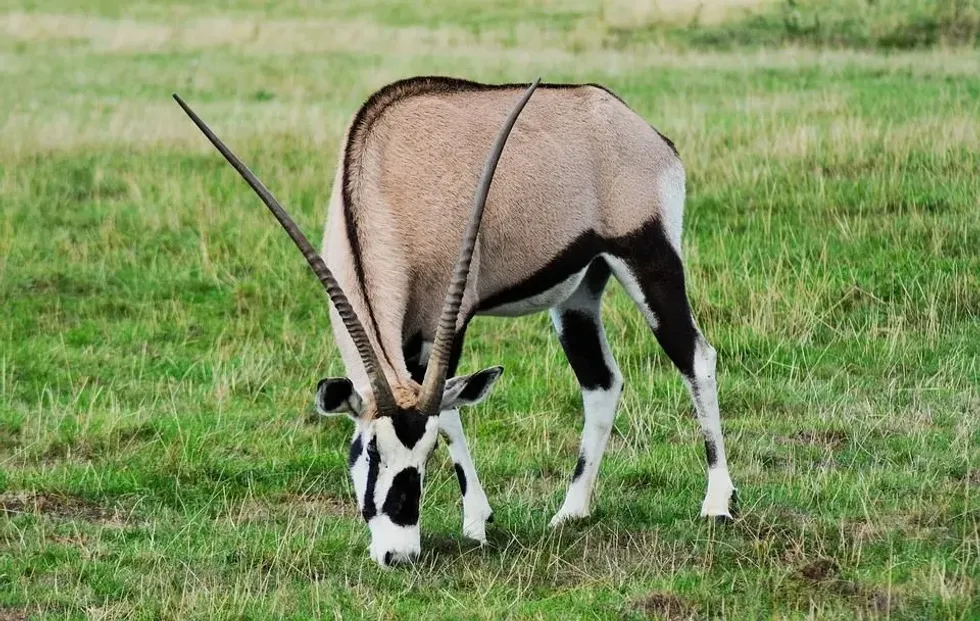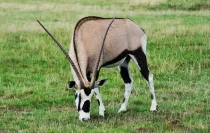If you are a lover of animals in the wild, then you might be eager to know more about the gemsbok. In this article, you will find all that there is to know about this powerful creature right here!
The gemsbok (Oryx gazella) is a large antelope belonging to the genus Oryx. It is considered one of the largest animals in the species and gemsboks are sociable animals.
They like to spend their time on open plains but their social interactions are limited to their respective groups or herds. They are mostly known for their majestic horns, which many hunters sadly go after them for, and this excessive poaching has led to a severe depletion in their population.
The males have horns that are thicker with a broad base whereas the females have horns that are longer but thinner.
They use their horns mainly for defending themselves from predators and other attacks. Horns are also used in sidelong jabs and for fencing actions in fights.
They are known to live in arid habitats and extreme desert conditions. The males are known for getting food and protecting the herd while females take care of the calves.
In this article, you will find information about gemsbok animal habitats, food, and behavior, so if you are wondering "what is a gemsbok? ", read on for the best gemsbok facts!
Gemsbok Interesting Facts
What type of animal is a gemsbok?
The gemsbok is an antelope. It is known to be among the larger animals of their kind.
What class of animal does a gemsbok belong to?
Gemsboks belong to the class of Mammalia and are categorized in the Oryx genus.
How many gemsbok are there in the world?
The current population of this species is estimated to be around 373,000 at this point in time in the wild.
Where does a gemsbok live?
Gemsboks live in the desert. The Kalahari Desert is one location where you might find a gemsbok.
What is a gemsbok's habitat?
Southern gemsboks inhabit open and arid habitats namely bush savanna and Kalahari dune land. Northern gemsboks stay in open grasslands.
They are said to be highly nomadic in nature and wander around the desert and through grasslands. As they cannot confine themselves to one area, they don't always have a specific habitat, but gemsboks tend to stay at places where they can find a water supply and vegetation.
Who do gemsbok live with?
Gemsbok live in the wild forming herds of around 10 to 40 individuals. They have a hierarchy within the herds with one dominant male, other non-dominant males, and females.
How long does a gemsbok live?
Gemsbok can live up to 20 years of age. The lifespan of these animals is between 18 and 20 years.
How do they reproduce?
The gemsbok is known to be polygamous in nature as the males mate with prospective females of the herd. The gemsbok does not really have a specified breeding season and hence reproduces throughout the year.
Female gemsbok leave the herd after getting pregnant and the gestation period after breeding can last for up to 270 days. Females give birth to one or two offspring.
The female is left alone for the gestation period in a safe place where she won't encounter any danger. After giving birth, the calf is kept in captivity for about six months, after which it rejoins the herd along with the mother.
The calf is weaned three and a half months after its birth and it becomes independent a month later.
It is the duty of the mother to look after the calf until then. The calves attain complete maturity by two years of age.
What is their conservation status?
The International Union for Conservation for Nature (IUCN)'s Red List has categorized the gemsbok as Least Concern. Large amounts of poaching for their horns and skin have led to a depleting population but currently, there are about 373,000 Gemsbok across the world so conservation experts are not concerned about this animal.
Gemsbok Fun Facts
What do gemsbok look like?

Gemsboks have a posture similar to a horse, have muscular shoulders and muscular necks. They have very distinctive tan, black, and white facial markings which make them easily identifiable. They are large antelopes with spear-like horns up to 48 in long.
They have a defined pattern of black markings that contrast with their white face and fawn body color. The head is marked with white and black triangular patches.
Some of them are also white and brown in color. They develop these characteristic markings at about three and a half months old. The patterns on northern gemsboks are generally darker in color, with thinner black markings than those from southern populations.
How cute are they?
Its very specific fur color features and its prized possession (its horns) make the gemsbok look very majestic and distinct. It is not cute in the conventional sense of the word but they definitely are a sight which you won't forget easily.
How do they communicate?
Gemsboks tend to keep to themselves within their herd and do not interact with other species. They do make loud noises to other members of the herd when they sense danger around them.
How big is a gemsbok?
Gemsboks are up to 47 in (120 cm) tall and 75-94 in (190-240 cm) long.
How fast can a gemsbok run?
The gemsbok can run up to a maximum speed of 37 miles per hour (60 km per hour).
How much does a gemsbok weigh?
The gemsbok weighs in a range of 220-530 lb (100-240 kg). The females weigh less than the males.
What are their male and female names of the species?
The scientific name for gemsbok is Oryx gazelle and they are a type of antelopes. Due to this, a male is called a buck while a female is called a doe.
What would you call a baby gemsbok?
A baby gemsbok is called a calf. A group of calves is called a herd of calves.
What do they eat?
Gemsboks generally feed themselves by eating grass and plants but the environmental conditions compel them to change their routine sometimes. During times when grass is scarce, the males dig very deep to find roots and tubers.
If they can find them, they also eat melons and cucumber since they have large water content. This helps them to meet their water requirements when living in groups in harsh desert conditions.
Are they aggressive?
Gemsboks tend to stick to their herds but are extremely dangerous and aggressive when cornered, threatened, or injured. Since they are under constant threat from humans and other predators both in the north and the south, they need to be powerful and aggressive in order to protect themselves and other members of their respective herds.
Would they make a good pet?
Gemsboks are a species that belongs in the wild in extreme desert conditions. This is their natural habitat and it is therefore not possible for humans to keep them as pets. Gemsboks are also very aggressive towards other species and hence will not make a good pet.
Did you know...
A low metabolism helps these antelopes to survive for most of the year without drinking water. Gemsboks extract water from fruit and vegetables like melons and cucumbers and they also have the special ability to produce concentrated urine to reduce any loss of body water.
They possess a developed mechanism for regulating their internal body temperature and are able to increase their body temperature to 113-96 F (45-35.7 C) in order to delay cooling by evaporation. The calf learns this survival skill at a very young age.
The meat of gemsbok has similarities with that of beef but it is leaner and quite juicy and succulent. It is considered a delicacy in Namibia.
What are gemsbok horns made of?
The horns are of the gemsbok are made out of keratin just like our fingernails and they grow on their heads during their lifetime. The only difference between the males and females of this species is their horns. The horns of the calves grow extremely fast.
How big can a gemsbok's horns get?
The gemsbok antelope is widely hunted for its horns. The average length of a gemsbok horn is around 33 in (83 cm).
Here at Kidadl, we have carefully created lots of interesting family-friendly animal facts for everyone to discover! You can even occupy yourself at home by drawing one on our gemsbok coloring pages.










